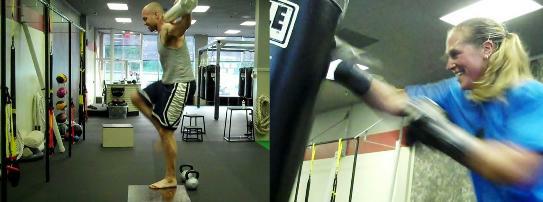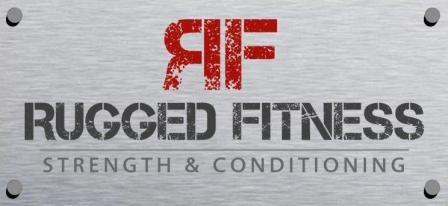Live Rugged!!!
Importance Of A Strong Hip Complex
by Rugged Coaches on 07/01/16
Contributed by Coach Tommy
We typically look at athletic movement and see limbs moving at amazing speeds. What gets noticed is the athlete's strong legs or muscled arms, but rather it is usually the bi-product of the much stronger muscles closer to the core.
When we think of which parts of our anatomy generate power, one of the muscles that should be at the top of the list are the Gluteals. These powerful hip, external rotation/extension muscles are the driving force in almost all athletic movements. If you take a look at any sprinter or power athlete you will notice a very defined backside.
This area is often overlooked in training programs, and also easily bypassed when executing a lift as well. We see a lot of lumbar back extension instead of hip extension, and it can be hard to turn off in some instances. We tend to use our back extensors much more when we also have a faulty breathing pattern. What I have seen a lot over the years are athletes and general population clients stuck in a state of sympathetic dominance. This means they are always ready for "action". If this pattern is always on it leads to a more extended postural position. The result is that the hips are now being dominated by an overactive back and diaphragm.
"We see tons of injuries to the hamstrings and lower back, but rarely encounter any sort of injury to the glutes. The fact of the matter is that most athletes are tight in the hamstrings, lower back and hip flexors. This collection of problems is related to the lack of strength and motor control in the gluteal muscles. Furthermore, when our 'butt' muscles aren't up to the task, the hamstrings and erector spinae are forced to work overtime to compensate. This unfortunate cycle often results in injury or at the very least, sub-optimal levels of performance." Eric Cressey (Cressey's Performance) & Mike Robertson (IFAST)
How do we reverse these patterns? It depends. Breathing drills help prime the trunk to be in a position for a better functioning hip. Another very important piece is being able to come out of that sympathetic state. If we can get the back extensor tissues to shut off, we may have a better opportunity to recruit the hip. More often than not, it isn't that a client needs more training, he/she actually needs a way to shut down, and then reset with a simple exercise to groove a more efficient pattern.
I like to use to a breathing drill, followed by a hip movement on the ground. It is easy to execute and doesn't require the body to fight against gravity as much and minimizes the number of joints involved.
Example: Glute bridge w breath
Watch
the 2 minute video and see if you can feel the difference when your
whole posterior chain works together. Try about 5-1o reps and note what
is working.
It is very different to see an athlete who can use
his/her glutes and whole posterior chain, compared to one that uses
just his/her back. Besides performance being improved, risk of low back
issues or injury in general is decreased. With a few consistent
strategies, this issue can be addressed efficiently and effectively.
You will notice this is a key component in each program.
Losing Weight Without Counting Calories
by Rugged Coaches on 05/31/16
 Contributed By Coach Danielle Weeks
Contributed By Coach Danielle Weeks
In this month's Rugged Podcast, Coach Dani discuses some of the simple techniques she teaches in our
Weight Loss Workshop that will help you to moderate your meal portion
sizes without having to go through the trouble of counting calories.
For more tips on weight loss or to get info on one of our upcoming
workshops, you can contact Coach Dani at Danielle.Weeks@areyourugged.com
I Just Want To Get Ripped! Why Should I Care About The FMS?
by Rugged Coaches on 03/29/16
Contributed By Coach Tommy

So you want to start a new exercise routine because your goal is to put on 5lbs of muscle while losing fat over the next 6 months. You have your nutrition all figured out and ready to go. After reading a great article on a exercise routine that looks promising, you start to training your butt off. It calls for Kettlebell front squats, overhead presses and lots of reverse lunges. After 2 weeks you notice that your low back has been a little sore and right knee is starting to act up. Not to mention your neck feels stiff in the morning. But you have 5 months and 2 weeks of training left, now what?
What if you had a map that told you, you might encounter some issues if you take path X and you should be okay if you take path Y. Also the rate of success would improve drastically if you weren't always taking 2 steps forward and 1 back. Wouldn't you be much more confident in your approach?
This is a story that happens every day. Even though kettlebell front squats are an excellent exercise, for someone with limited hip or
ankle mobility they could be the worst thing possible for them to attempt. But
how would you know if you fit into this category? This is where using a movement screening tool, like the FMS, can help shed some light on what is going to be a long term
success strategy, rather than a short term high cost practice. Movement just
like nutrition needs a detailed approach and some objective feedback that can
lead us in the right direction. But just like nutrition everyone is different.
Since we are all human we can have some standards and some things that will
fall in a grey area.
So before you jump right into the next Men's Fitness article workout, come in for a free Strategy Session with one of our coaches and let us help you figure out what the best workout is for you. Here's a link to an overview of the screening process and how we utilize it: https://youtu.be/nlZf04uZVZk
Help Us Support Veteran Suicide Awareness & Prevention
by Rugged Coaches on 03/17/16
We have recently become aware of an organization called 22Kill.com that is dedicated to raising awareness of and helping to prevent veteran suicide. With many friends, members and family of the Rugged team being veterans, this charity hits close to home for us. We have committed to helping raise awareness for this organization by participating in the Push Up Challenge that they have established. Much like the Ice Bucket Challenge last year, this challenge evolves participants recording themselves doing 22 push ups and posting it to social media tagging and shouting out the organization and calling on others they know to do the same.
Check out the YouTube video we put together:
https://www.youtube.com/watch?v=an7rYeE-oaY
and help us reach our 2500 push up goal by posting your own video to social media and tagging Rugged Fitness and 22Kill.
Movement Pillar - Why We Have Brains
by Rugged Coaches on 03/11/16
Contributed By Coach Tommy
In the this ted talk: https://www.youtube.com/watch?v=7s0CpRfyYp8, Daniel Wolpert gives us a glimpse of what some of the main functions of the brain are and how our cognitive development as a species is focused around our necessity for movement. This seems like it may be crazy but when analyzed in everyday life you notice that without movement we really aren't capable of anything. When we look at the oldest parts of the brain or "reptilian brain" we are talking about the brain stem and cerebellum. The cerebellum is where the motor cortex is. This is responsible for human movement. Now imagine this very old part of the brain, that is also responsible for your ability to interact with the world, has some corrupted files in it.
"Poor movement can exist anywhere in the body but poor movement patterns can only exist in the brain"- Gary CookFrom infancy you learned all these patterns and timed them
to cause locomotion. Through trial and error your brain figured out what was
the most efficient way to move and stored them. When we are trying to improve technique or efficiency, what
we ultimately are trying to do is change the brain. A good question would be "is there a way to check to
see how my movement is?" "Has it been altered or am I still able to
perform?" The FMS is a great tool and starting point to establish a
baseline and rule out things that can be detrimental. We will go over in more detail in our upcoming content about
screening and the FMS.




